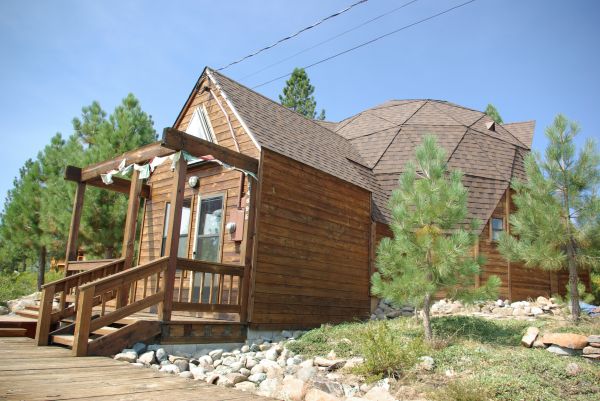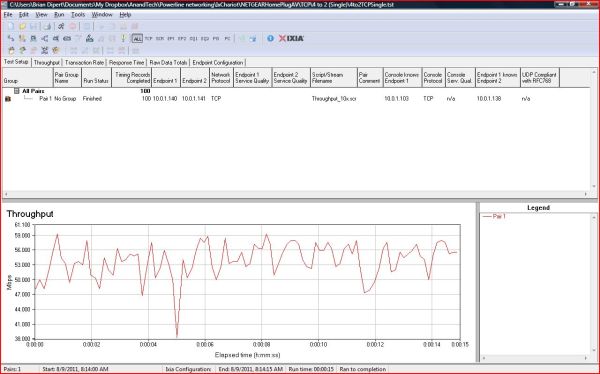Hands-On Powerline Networking: How Well (Or Not) Are Latest-Generation Devices Working?
by Brian Dipert on September 1, 2011 12:41 AM EST- Posted in
- Networking
- Powerline Adapters
- NetGear
My approximately 1300-square-foot geodesic-dome residence dating from the mid-1980s serves as my test bed.
Three of the powerline-network nodes I tested were in the approximately 25-foot-diameter downstairs main room:
- Against one wall in a dining-room nook (node 1)
- In the middle of the room on a stairwell near the entertainment system, (node 2)
- Against the opposing wall near the router (a 'fall 2007' Apple Airport Extreme N, model MB053LL/A, with GbE LAN ports).
Next door to the router is the "mud room", containing the fourth power outlet I employed in the testing (node 4), as well as the circuit-breaker box. I used another entertainment system in the upstairs bedroom as the fifth power-line node (node 3). Each AC outlet connects to a phase of the premises' 220V power feed, but I didn’t know (and intentionally didn't try to figure out, thereby mimicking a typical consumer's approach) which phase or which circuit breaker each network node employed.
Per the discussion in the prior section of this writeup, I employed various measures to minimize the effect of attenuation for these tests. I ensured that surge protectors and UPSs weren't between any of the power-line adapters and their associated power outlets. As a long-time powerline networking veteran, I have noise filters permanently installed between the power grid and both my refrigerator’s compressor and my home’s furnace fan; neither the refrigerator, furnace nor any other motors were operating when I was logging benchmark results. I also kept fluorescent bulbs extinguished, and I unplugged all of my AC adapters, battery chargers, and other wall-wart-based and otherwise AC-to-DC-fueled devices.
With respect to benchmarking utilities, AnandTech's Brian Klug leveraged iPerf (an open-source package I've also extensively used in the past) for his recent testing of Apple's latest generation Airport Extreme router and Time Machine. And Jarred Walton harnessed a suite of software in his more recent evaluation of Bigfoot’s Killer-N 1102 Wireless Half-Mini PCIe 1.1 add-in module. In my particular case, I went with another program I'd used before, Ixia's IxChariot. IxChariot’s Console utility, a Microsoft Windows application, sets up, manages, and periodically collects data from various tests.
The companion network-node-resident utility, Ixia’s Endpoint, runs on Linux, Mac OS X, and Windows OSes. Console comes with more than 100 company-created scripts, and users can also customize them and create brand-new scripts. Because Console also bundles Endpoint, you can theoretically run Console from the same machine that acts as one of the tested network nodes. However, as I'd learned in the past, such a setup is not optimal for accurate testing. Using the same system CPU resources for both Console and Endpoint means that you may be unable to run either of them at full speed. Console and Endpoint functions also contend for limited networking-transceiver bandwidth.
Alternatively, as I did in these particular tests, you can run Endpoint software on two systems, with the Console utility executing on a third computer that communicates with the other two. In that case, the Console-installed PC can also have lower network performance than the others. According to Michael Githens, lab-programming manager at Ixia, “It doesn’t need a high-speed connection, [as the test links do]. It is passing less data; the results come only from the test links, not the management links.” And in fact, the Console communication with each Endpoint in my particular setup occurs over Wi-Fi, so as to not impede the Endpoint-to-Endpoint traffic flow over the power grid (which would therefore under-report the performance potential of any particular powerline networking span).
However, I chose to disregard one other Ixia setup recommendation offered by Intellon-then-Atheros-now-Qualcomm, who sells the silicon inside two of the three powerline adapters tested in this study. Qualcomm suggested that I give the Endpoint systems' wired Ethernet transceivers (therefore the powerline adapters connected to them) static IP assignments, thereby enabling them to directly communicate with each other with no periodic router overhead. While Qualcomm's proposal is likely accurate in its prediction, it doesn't match the DHCP-assigned way that the bulk of LAN clients in both corporate and consumer settings obtain their IP addresses. As such, I left the Endpoints at their DHCP-configured defaults, thereby explaining the fifth powerline adapter in my topology, connected to the router for DHCP assignments (and renewals) and other like functions.
My Console-running system is a Dell XPS-M1330 laptop, based on Windows Vista Ultimate. As previously mentioned, it interacts with the two Endpoints over 802.11n Wi-Fi connections. The Endpoint systems are both Macs, a first-generation May 2006 13" MacBook running Mac OS 10.5 Leopard and an April 2010 13" MacBook Pro based on Mac OS 10.6 Snow Leopard. Both of the latter two systems contain GbE transceivers, a critical requirement for matching up with the GbE ports in the '500 Mpbs' IEEE 1901 powerline adapters I evaluated.












53 Comments
View All Comments
EarthwormJim - Thursday, September 1, 2011 - link
You can typically follow other wiring in the house when retrofitting, like telephone wiring or coaxial wiring.Competition is probably high in my area, I often see several advertised specials from electricians specifically for cat 5 wiring.
bobbozzo - Thursday, September 1, 2011 - link
If you have (wall-to-wall) carpet, it's very easy to lift up the carpet a little and run cat5 under it... I ran a 100' drop in about 15mins.Also, you can get baseboard or crown molding which are gapped or routed (cut out) for wires to be hidden in.
e.g.
http://www.curbly.com/Chrisjob/posts/3618-Hide-you...
http://www.wiretracks.com/prod-cm.html
bobbozzo - Thursday, September 1, 2011 - link
Also, my alarm guy does cat5 drops through the attic for $30 each, which is a real bargain. He drops them behind curtains, etc., instead of through the walls to a wall box.bdipert - Thursday, September 1, 2011 - link
Dear bobbozzo, thanks for writing. You do realize, thought, that the feasibility and availability of such wiring options (far from their implementation) are way beyond the comprehension of the consumer masses...right? Versus going down to a nearby consumer electronics store, buying a couple of adapters, and plugging them into power outlets? If consumer electronics manufacturers targeted only the readers (and editors ;-) ) of AnandTech, they'd be able to get away with far less consumer-friendly offerings, because the bleeding-edge early adopters here would figure 'em out anyway. But the potential customer market would be a fraction of the size, as a result.bjacobson - Thursday, September 1, 2011 - link
can you review it, too?bdipert - Thursday, September 1, 2011 - link
Glad you all seem to dig my digs. I do, too ;-)bigpow - Thursday, September 1, 2011 - link
As someone who actually makes a living testing powerline comm, I find your article to be refreshing. Had to close my eyes and bite my tongue, going through the HW section, LOL, but everything after that is quite informative.fausto412 - Thursday, September 1, 2011 - link
i've been interested in this to run my home network and hookup my PC to the net over wireless..i also have 2 to 3 TIVO's i would love to network over faster speeds than wireless which would allow me to transfer shows real time between boxes.anybody able to speak to the capability of these setups in the real world?
froob - Friday, September 2, 2011 - link
Did you run any latency tests on these units? I'm interested to know how suitable Powerline networking would be for an Xbox 360 / PS3 etc.bdipert - Friday, September 2, 2011 - link
Dear froob,Yes, IxChariot logs a number of statistics, including latency, packet drop percentage, etc, I didn't explicitly create a table for latency, but you can find the data in the full report files I've archived here (as published in the 'TCP Testing Results' section of the article):
http://images.anandtech.com/doci/4695/PowerlineBen...